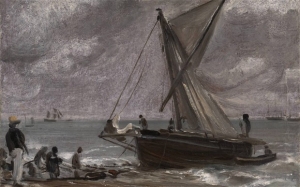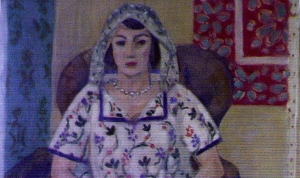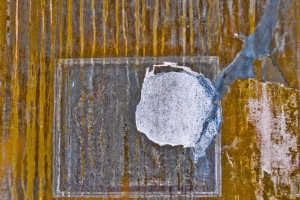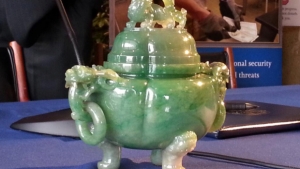|
Displaying items by tag: Stolen

The Tate Gallery in London has agreed to return John Constable’s “Beaching a Boat, Brighton” to the heirs of a Jewish Hungarian art collector. The painting, which is listed on the University of Oxford’s looted art registry, was stolen from Baron Ferenc Hatvany while he was in hiding during World War II. Documents show that Hatvany acquired the Constable painting in 1908 at an auction in Paris.
The Tate received “Beaching a Boat, Brighton” in 1986 from a donor identified as Mrs. P.M. Rainsford, who had acquired the work in 1962. After the Tate received the painting, it failed to make its complete provenance public. Two years ago, Hatvany’s heirs learned that the Constable painting was in the Tate’s collection and in 2013, they formally submitted a claim to the Spoliation Advisory Panel, which was established by the British government to settle looting claims on artworks in public collections. The panel criticized the Tate for failing to thoroughly investigate the painting’s provenance.
The Tate released a statement saying that it was “grateful for the care with which the Panel has examined the evidence and is pleased to follow the conclusions of the report...Tate will therefore recommend to its Trustees, when they next meet in May, that the work be returned to the claimants.”

Cornelius Gurlitt, the German man who had been hoarding a trove of Nazi-looted artworks in his Munich apartment, has agreed to return the works to their rightful owners. Gurlitt's lawyers are currently working with the descendants of Paul Rosenberg, a French art dealer, to return Henri Matisse's "Seated Woman/Woman Sitting in Armchair."
In November 2013, it was reported that in 2012, more than 1,400 artworks were uncovered in Gurlitt's apartment. In February 2014, around 60 more works were found in an Austrian home owned by Gurlitt, including works by Claude Monet, Pierre-Auguste Renoir, and Pablo Picasso. Two subsequent visits turned up 178 more works.
Gurlitt, 81, is the son of the art dealer Hildebrandt Gurlitt, who reportedly acquired the works in the late 1930s and 1940s. Gurlitt's father had been put in charge of selling the stolen artworks abroad by Joseph Goebbels, Hitler's Minister of Propaganda, but secretly hoarded many of them and later claimed that they were destroyed in the bombing of Dresden. Gurlitt sold a number of the paintings over the years and lived off of the profits.
In November 2013, Gurlitt announced that he would not negotiate the return of the works in his possession.
A French man admitted to police that he stole Rembrandt’s “Child with a Soap Bubble” from the Municipal Museum in southeastern France. The work was recovered last week after French police caught the unidentified man and an accomplice attempting to sell the painting, which is estimated to be worth around $5.4 million. The painting has been missing since 1999.
The burglar, who said that he never earned any money from the painting, told police that he stole the canvas by breaking into the municipal library next door to the museum during a Bastille Day parade. Authorities returned the painting to curator Jeanine Bussieres on Thursday, March 20. Bussieres told the AP, “We are thrilled...this Rembrandt was one of our masterpieces. The child in the picture is smiling because he has a soap bubble. But yes, he could be smiling now because he’s been returned to us.”
The Municipal Museum acquired the 17th century painting in 1794, making it one of institution’s first acquisitions.

Last week, it was discovered that part of a fresco was missing from the ancient Roman city of Pompeii. It is believed that thieves broke into a closed-off section of the UNESCO World Heritage site and chiseled off a portion of the fresco bearing a depiction of the Greek goddess Artemis.
Police have launched an investigation into the disappearance of the eight-inch wide fragment. They will be reviewing surveillance footage from the perimeter of the site in hopes of identifying the thieves, but there are no security cameras within the ruins.
Professor Umberto Pappalardo, an archaeological expert at the Suor Orsola Benincasa University in Naples, told AFP he believes petty criminals were behind the theft, rather than art thieves aiming to sell the fragment on the international market. Pappalardo added, “Selling a stolen fresco from a site as well documented as Pompeii would be a very, very tall order. There would certainly not be any market for it in Italy.”
In January, a fragment of fresco was taken from another part of Pompeii and sent to the curator’s office in an anonymous package. Pompeii, one of Italy's main tourist attractions, has become a symbol for decades of mismanagement of the country's cultural sites. Italy's new Culture Minister, Dario Franceschini, has promised to increase maintenance work at Pompeii.
After more than 17 years, police have reopened the investigation into a theft from the Ricci-Oddi Gallery in northern Italy. In February 1997, while the gallery was undergoing a renovation, thieves made off with Gustav Klimt’s “Portrait of a Woman.” The assailants, who either entered the gallery through the main entrance or removed the work through the building’s skylight, left a partial fingerprint on the painting’s frame. Investigators hope that today’s state-of-the-art technology will help identify a DNA match for the print.
The Klimt painting, which depicts a dark-haired woman, was acquired by the Ricci-Oddi Gallery in 1925. “Portrait of a Woman” is one of the most sought-after stolen paintings in Italy.
Klimt, an Austrian symbolist painter, was one of the most prominent members of the Vienna Secession movement. He is currently the subject of an exhibition at the Palazzo Reale in Milan.
Earlier this year, a judge ordered that a painting by Pierre-Auguste Renoir be returned to the Baltimore Museum of Art. The work, which had been purchased in 2009 at a Virginia flea market, was stolen from the museum in 1951.
Martha Fuqua, the woman who made the seven-dollar flea market purchase, argued that she deserved to hold on to “On the Shore of the Seine,” a small landscape painting, because she was unaware that it had been stolen when she purchased it. Fuqua attempted to sell the work at auction for $100,000, but it was confiscated by the FBI after it was revealed that the painting belonged to the museum.
“On the Shore of the Seine” will be on view at the Baltimore Museum of Art from March 30 through July 20.
Le Corbusier’s Chapel of Notre Dame du Haut in Ronchamp, France, one of the most important works of 20th-century ecclesiastical architecture, was severely damaged by vandals on Friday, January, 17. The suspects stole a concrete trunk, damaged a door and smashed a stained-glass window that was hand-finished by the Franco-Swiss architect with an original illustration. France’s Department of Historic Monuments has deemed the window to be irreplaceable.
The chapel is a unique work for Le Corbusier as it is smaller in scale and exhibits curvilinear forms as well as traditional iconography. Le Corbusier is credited with changing the face of urban architecture and is known for his efficient yet austere style.
The Chapel of Notre Dame is still used regularly by its adjoining abbey.

Nearly 35 years ago, a Chinese jade artwork from the 18th century was stolen from a display case at Harvard University’s Fogg Museum. The censer, or incense burner, was returned to the museum on Tuesday, January 21, by the U.S. Department of Homeland Security’s Immigration and Customs Enforcement division following a lengthy investigation. The object is estimated to be worth $1.5 million.
The green jade censer was donated to the Fogg Museum in 1942 and disappeared shortly after Thanksgiving in 1979. The work remained out of public view until it appeared at Sotheby’s in Hong Kong in 2009. When the censer’s seller failed to provide documentation about the piece’s ownership history, Sotheby’s ran the object through the Art Loss Register of London. The database, which lists works that have been stolen, looted or disputed, alerted the U.S. government of the object’s reappearance and Homeland Security launched its investigation.
A ceremony was held at the Fogg to welcome the jade censer back into the museum’s collection.
Federal officials have returned three stolen antiquities estimated to be worth around $1.5 million to the Indian Consulate in New York. The United States Department of Homeland Security Investigations has been working with India to recover dozens of stolen artifacts in recent years.
All three of the works date from the 11th or 12th century and include a sandstone sculpture that had been stolen from an Indian temple in 2009. The 350-pound work, which depicts the deities Vishnu and Lakshmi, had been listed as one of the Interpol’s top 10 stolen artworks. The other recovered artifacts include a 400-pound figurative sculpture and a black sandstone sculpture depicting the male deity Bodhisattva.
A ceremony was held on Tuesday, January 14 at the Consulate.
A judge has ordered that a painting by Pierre-Auguste Renoir that was allegedly purchased at a flea market for $7 in 2009, be returned to the Baltimore Museum of Art. The museum filed papers in federal court last year arguing that the work legally belonged to the institution and had been stolen while on view there in 1951.
Martha Fuqua, who had purchased the painting at a Virginia flea market, claimed that she deserved to hold on to ‘On the Shore of the Seine’ (1879), a small landscape painting, because she was unaware that it had been stolen. The FBI seized the work in 2012 from an auction gallery. Fuqua had hoped to sell the unsigned work for as much as $100,000.
The Baltimore Museum of Art released a statement saying, “We look forward to celebrating the painting’s homecoming with a special installation in the galleries in late March.”
|
|
|
|
|